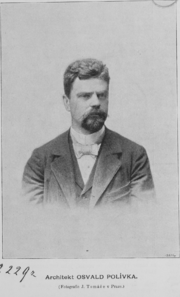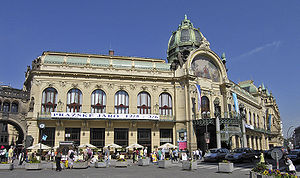
Osvald Polívka
Encyclopedia



Art Nouveau
Art Nouveau is an international philosophy and style of art, architecture and applied art—especially the decorative arts—that were most popular during 1890–1910. The name "Art Nouveau" is French for "new art"...
period in Prague. Polívka designed many of Prague's significant landmarks of the era, plus other work in Brno
Brno
Brno by population and area is the second largest city in the Czech Republic, the largest Moravian city, and the historical capital city of the Margraviate of Moravia. Brno is the administrative centre of the South Moravian Region where it forms a separate district Brno-City District...
and elsewhere.
After graduating from Czech Polytechnic in Prague, his first important commission was a collaboration with Antonín Wiehl, the 1894 Prague City Savings Bank. Polívka's style evolved through his active years but he remained devoted to the collaborating with artists for aesthetic effect. For the ornate landmark Municipal House he coordinated the work of many significant Czech muralists and sculptors of the time, including his friend Alfons Mucha
Alfons Mucha
Alfons Maria Mucha , known in English as Alphonse Mucha, was a Czech Art Nouveau painter and decorative artist, known best for his distinct style. He produced many paintings, illustrations, advertisements, postcards, and designs.-Early years:...
.
Major architectural projects
- Prague City Savings Bank, Old Town Square, together with Antonín Wiehl, 1894, with distinctive architectural sculptural groups by Bohuslav SchnirchBohuslav SchnirchBohuslav Schnirch , was a Czech sculptor perhaps best known for his architectural sculpture. Schnirch sculpted 10 of the 20 roof statues, and the interior sculpted pediment, on Josef Zítek's 1881 National Theatre ....
- Assicurazioni Generali offices, now the Viola Building, with Friedrich Ohmann, #7 Wenceslas SquareWenceslas SquareWenceslas Square is one of the main city squares and the centre of the business and cultural communities in the New Town of Prague, Czech Republic. Many historical events occurred there, and it is a traditional setting for demonstrations, celebrations, and other public gatherings...
, 1897 - U Nováků department store, 1902-1903
- co-architect with Municipal HouseMunicipal HouseThe Municipal House is a major civic landmark and concert hall in Prague, and an important building in architectural and political history in the Czech Republic. It stands on the Náměstí Republiky....
(Obecní dům), with Antonín Balšánek, 1904-1912 - Topič House, circa 1905
- New Town Hall, 1908-1911, with architectural sculpture by Stanislav SuchardaStanislav SuchardaStanislav Sucharda , Czech sculptor and professor at the Prague School of Applied Arts from 1899, and a leading figure in the Mánes Union of Fine Arts Stanislav Sucharda (1866–1916), Czech sculptor and professor at the Prague School of Applied Arts from 1899, and a leading figure in the Mánes Union...
, Josef Mařatka and Ladislav ŠalounLadislav ŠalounLadislav Jan Šaloun was an important Czech sculptor of the Art Nouveau period.Šaloun studied in the studios of Tomáš Seidan and Bohuslav Schnirch, was involved as an artist in the Mánes Union of Fine Arts, This independent education allowed him to avoid the influence of Josef Václav Myslbek,... - Gallery of Modern Art in Hradec KrálovéHradec KrálovéHradec Králové is a city of the Czech Republic, in the Hradec Králové Region of Bohemia. The city's economy is based on food-processing technology, photochemical, and electronics manufacture. Traditional industries include musical instrument manufacturing – the best known being PETROF pianos...
, 1912, with allegorical sculpture by Šaloun flanking the entrance

